East Ashford, Kent
Up to 1834
A parliamentary report of 1777 recorded parish workhouses in operation at Brabourne (for up to 30 inmates), Eastwell (10), Mersham (12), and Wye (40).
The Five Bells public house in Brabourne was originally built as the parish workhouse.
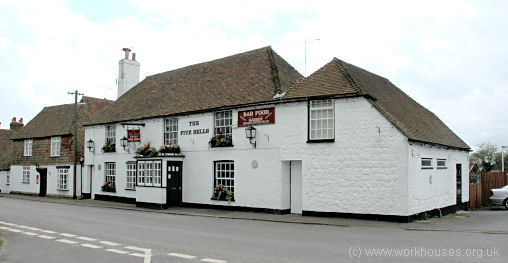
Brabourne former parish workhouse, 2005.
© Peter Higginbotham.
After 1834
East Ashford Poor Law Union was formed on 3rd June 1835. Its operation was overseen by an elected Board of Guardians, 22 in number, representing its 22 constituent parishes as listed below:
Kent: Aldington, Bilsington, Bircholt, Bonnington, Boughton Aluph, Brabourne, Brook, Challock, Chilham, Crundale, Eastwell, Godmersham, Hastingleigh, Hinxhill, Hurst, Kennington, Mersham, Moldash, Orleston*, Ruckinge*, Sevington, Smeeth, Warehorne*, Willesborough, Wye (* additions from 25th April 1836).
The population falling within the (enlarged) Union at the 1831 census had been 10,751 with parishes ranging in size from Hurst (population 40) to Wye (1,639). The average annual poor-rate expenditure for the period 1833-5 had been £12,891 or £1.4s.0d. per head of the population.
In 1837, the East Ashford Union erected a workhouse on the west side of Kennington Road in Ashford. It was designed to accommodate 350 inmates and the architect was John Whichcord of Maidstone whose plan was based on Sir Francis Head's model courtyard design which was also adopted by other Kent unions such as Bridge, Cranbrook, Dartford, Eastry, Malling, and Tonbridge.
In 1897-98, an infirmary was added at the west of the main building. The layout and location of the site is shown on the 1898 map below:
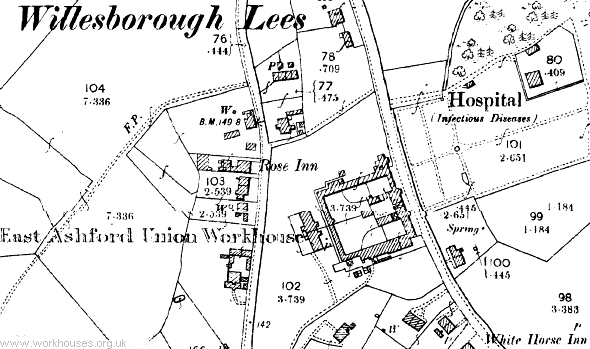
East Ashford workhouse site, 1898.
The two storey building was constructed in red brick.
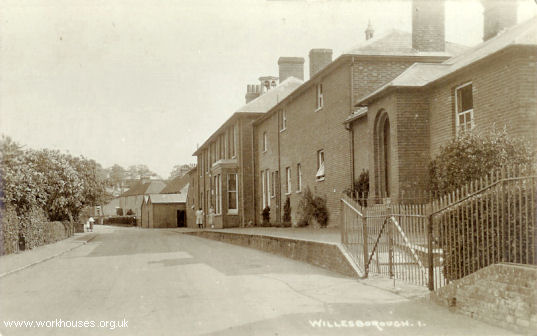
East Ashford main block from the north, c.1905.
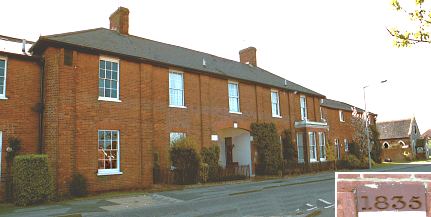
East Ashford main block from the south-east, 2001.
© Peter Higginbotham.
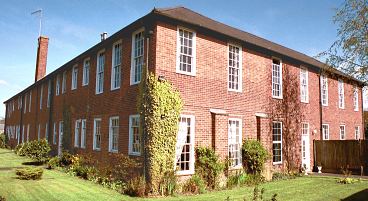
East Ashford from the south, 2001.
© Peter Higginbotham.
By 1908, a chapel had been erected at the north of the site.

East Ashford chapel from the north, 2001.
© Peter Higginbotham.
The workhouse later became Willesborough Institution, then was known as Gill House, and later as Willesborough Hospital. It has now been converted to residential use. The chapel is now used as a children's nursery.
Children's Home
In around 1915, the East Ashford Union opened a children's home known as The Hostel, at Wye. It could accommodate 30 children.
Staff
Inmates
Records
Note: many repositories impose a closure period of up to 100 years for records identifying individuals. Before travelling a long distance, always check that the records you want to consult will be available.
-
Kent History and Library Centre, James Whatman Way, Maidstone, Kent ME14 1LQ
Holdings include:
- Guardians' minutes (1835-1930); Workhouse admissions and discharges (1836-99); Deaths (1836-1906); etc.
- The Hostel, Wye: Admissions and discharges (1915-32); Superintendent's day book (1915-25); Superintendent's report book (1927-35); Medical Officer's report book (1929-35); Visitor's book (1911-35).
Bibliography
- Higginbotham, Peter Workhouses of London and the South East (2019)
- None.
Links
- None.
Unless otherwise indicated, this page () is copyright Peter Higginbotham. Contents may not be reproduced without permission.


